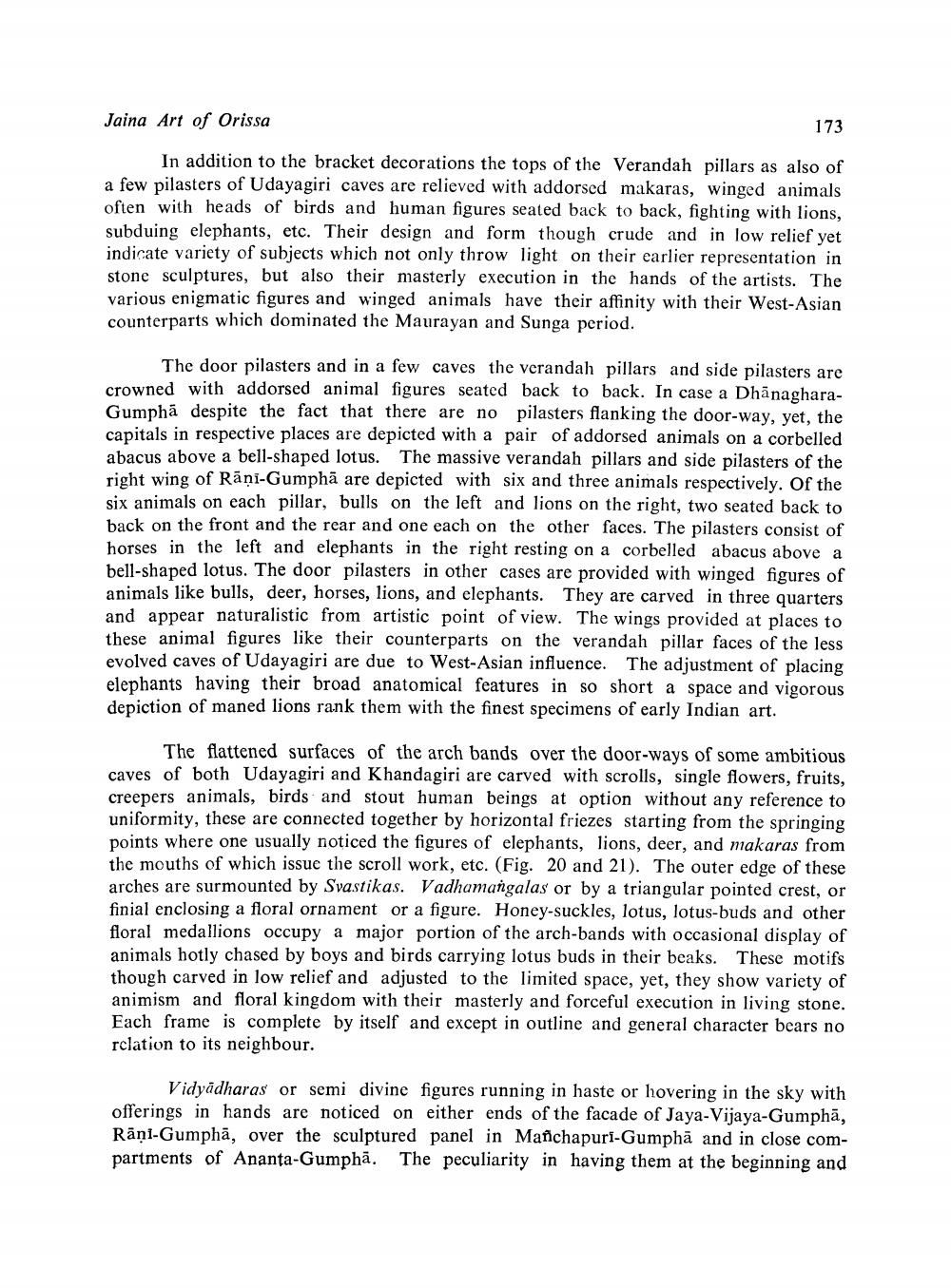________________
Jaina Art of Orissa
173
In addition to the bracket decorations the tops of the Verandah pillars as also of a few pilasters of Udayagiri caves are relieved with addorsed makaras, winged animals often with heads of birds and human figures seated back to back, fighting with lions, subduing elephants, etc. Their design and form though crude and in low relief yet indicate variety of subjects which not only throw light on their earlier representation in stone sculptures, but also their masterly execution in the hands of the artists. The various enigmatic figures and winged animals have their affinity with their West-Asian counterparts which dominated the Maurayan and Sunga period.
The door pilasters and in a few caves the verandah pillars and side pilasters are crowned with addorsed animal figures seated back to back. In case a DhānagharaGumpha despite the fact that there are no pilasters flanking the door-way, yet, the capitals in respective places are depicted with a pair of addorsed animals on a corbelled abacus above a bell-shaped lotus. The massive verandah pillars and side pilasters of the right wing of Rāņi-Gumphā are depicted with six and three animals respectively. Of the six animals on each pillar, bulls on the left and lions on the right, two seated back to back on the front and the rear and one each on the other faces. The pilasters consist of horses in the left and elephants in the right resting on a corbelled abacus above a bell-shaped lotus. The door pilasters in other cases are provided with winged figures of animals like bulls, deer, horses, lions, and elephants. They are carved in three quarters and appear naturalistic from artistic point of view. The wings provided at places to these animal figures like their counterparts on the verandah pillar faces of the less evolved caves of Udayagiri are due to West-Asian influence. The adjustment of placing elephants having their broad anatomical features in so short a space and vigorous depiction of maned lions rank them with the finest specimens of early Indian art.
The flattened surfaces of the arch bands over the door-ways of some ambitious caves of both Udayagiri and Khandagiri are carved with scrolls, single flowers, fruits, creepers animals, birds and stout human beings at option without any reference to uniformity, these are connected together by horizontal friezes starting from the springing points where one usually noticed the figures of elephants, lions, deer, and makaras from the mouths of which issue the scroll work, etc. (Fig. 20 and 21). The outer edge of these arches are surmounted by Svastikas. Vadhamangalas or by a triangular pointed crest, or finial enclosing a floral ornament or a figure. Honey-suckles, lotus, lotus-buds and other floral medallions occupy a major portion of the arch-bands with occasional display of animals hotly chased by boys and birds carrying lotus buds in their beaks. These motifs though carved in low relief and adjusted to the limited space, yet, they show variety of animism and floral kingdom with their masterly and forceful execution in living stone. Each frame is complete by itself and except in outline and general character bears no relation to its neighbour.
Vidyādharas or semi divine figures running in haste or hovering in the sky with offerings in hands are noticed on either ends of the facade of Jaya-Vijaya-Gumphā, Rāņi-Gumphā, over the sculptured panel in Mañchapuri-Gumpha and in close compartments of Ananta-Gumphā. The peculiarity in having them at the beginning and




